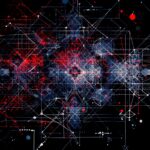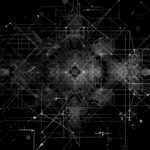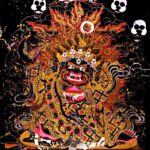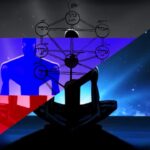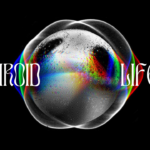Original: Roger Caillois, «Mimétisme et psychasthénie légendaire », Minotaure, no. 7, 1935
Roger Caillois is a peculiar figure of the 20th century intellectual scene. Surpassed in fame by his friend and colleague Georges Bataille, with whom he founded the Collège de sociologie in Paris in 1937 and with whom he shared the experience of Acèphale, Caillois was a sprawling thinker, a fluid penetrating the pores of the various domains of knowledge in search of something independent, prior, more elementary from that knowledge. In this text, between biology, psychology and mysticism – a text anticipating schizoanalysis and the inspiration fro Lacan’s notion of the mirror stage – Caillois analyses the secret dance between survival strategies and human imagination, between the consistency of the subject and the space that surrounds it, the defence mechanisms of the former and the voracity of the environment in which it immerses itself. In an era of such vehement metamorphosis, between sensory urbanism, stratification of intelligences, multiplication of the spaces in which subjectivity is thrown and created (universes and metaverses), Caillois’s reflection returns as fundamental: what distance exists between the subject and its environment? Does a distance exist at all?
_______________________________________________
Beware: Whoever pretends to be a ghost will eventually turn into one.
Ultimately, from whatever angle one may approach things, the fundamental question proves to be that of distinction: distinctions between what is real and imaginary, between wakefulness and sleep, between ignorance and knowledge, and so on. These are all distinctions, in short, that any acceptable project must seek to chart very precisely and, at the same time, insist on resolving. Certainly, no distinction is more pronounced than the one demarcating an organism from its environment; at least, none involves a more acutely perceptible sense of separation. We should pay particular attention to this phenomenon, and more specifically to what we must still call, given our limited information, its pathology (although here the term has a purely statistical meaning): namely, the set of phenomena referred to as mimicry.
For a long time, and for various reasons (often not very good ones), biologists have liked to focus on these facts with all sorts of ulterior motives. Some biologists sought to prove transformationism, which luckily has other foundations; others sought to prove the knowing providence of the celebrated God whose benevolence encompasses all of nature.1
Under these circumstances, a stringent method is absolutely necessary. First and foremost, these phenomena must be classified with great rigor, for past experience has shown that the have been confused with each other for all sorts of wrong reasons. As far as possible, one should even adopt a classification deriving from the phenomena themselves rather than from their interpretations, which may well be biased and which, anyway, are almost always controversial in every case. Therefore, I shall mention Giard’s two categories – but without retaining them.2 The first comprises offensive mimicry, meant to surprise one’s prey, and defensive mimicry, either to hide oneself from an aggressor (concealing mimicry) or else to terrify the aggressor by means of one’s deceptive appearance (frightening mimicry). The second category comprises direct mimicry, when the mimicking animal has an immediate interest in disguising itself, and indirect mimicry, when animals from different species display “professional resemblances,” as it were, due to some common adaptation, or convergence.3
***
[…]
***
It has been surmised that a harmless animal took on the guise of a formidable one in order to protect itself. Consider, for example, the Trochilium butterfly and the Vespa crabro wasp: both have the same smoky wings, the same legs and brown antennae, the same abdomen and thorax with yellow and black stripes, the same sturdy and noisy way of flying in broad daylight. Sometimes, the mimetic creature carries this further: for example, the Choerocampa elpenor caterpillar. This insect has two eye-shaped marks ringed with black on its first and fifth sections; when it is disturbed, the front rings retract and the fourth ring swells up sharply. It is claimed that the effect thus produced is a snake’s head capable of tricking lizards and small birds, which are frightened by this brusque apparition.4 According to Weissmann, when the Smerinthus occellata (which, like all sphinx moths, hides its lower wings in the state of repose) is in danger, it suddenly reveals these wings, whose two big blue “eyes” on a red background surprise and terrify the aggressor.5
With its wings outstretched, the butterfly thereby becomes the head of a great bird of prey. Certainly the clearest example of this kind is the Caligo butterfly of the Brazilian forests, which Vignon described as follows: “There is a bright spot surrounded by a palpebral ring, then overlapping circular rings of irregularly colored little radial feathers, all of which perfectly imitates the plumage of an owl, while the butterfly’s body corresponds to its beak.”6 The resemblance is so striking that the native inhabitants of Brazil nail the butterfly to their barn-doors as a substitute for the animal it mimics.
It is all too clear that anthropomorphism plays a decisive role in the foregoing cases: the resemblance exists solely in the eye of the beholder. The objective phenomenon is the fascination itself. This is illustrated, in particular, by the Smerinthus ocellata, which does not look like anything dangerous at al. Only the eye-shaped markings come into play: the behavior of the native Brazilian inhabitants simply serves to confirm this opinion. The “eyes” of the Caligo should probably be correlated with the apotropaic Oculus indiviosus, the evil eye that not only harms but can also protect once it has been turned against the evil powers to which it naturally belongs, as an organ of fascination par excellence.7
Here the anthropomorphic objection does not hold, for the eye is the vehicle of fascination throughout the entire animal kingdom. With regard to the tendentious claim of resemblance, on the contrary, the objection is decisive; moreover, even from a human perspective, no resemblance in this group is fully conclusive.
***
There are many examples of one form adapting to another (homomorphy). Calappae resemble rolled pebbles; chlamydes, seeds; monas, gravel; and palea, sea wrack. The Phyllopteryx fish, from the Sargasso Sea, is merely a kind of “tattered seaweed shaped in floating strips,” like the Antennarius and the Pterophryné.8 The octopus retracts its tentacles, curves its back, adapts its color, and thus looks like a rock. The lower green-and-white wings of the Dawn-Pierid simulate umbelliferae, and the dents, nodules, and stria ribs of the symbiotic lichmea make it appear identical to the popular tree bark on which it lives.
The Lithinus nigrocristinus of Madagascar and the Flatoides are indistinguishable from lichens. 9 Mantidae mimicry goes very far; with their feet simulating petals or else curling up into corolla, they look like flowers and imitate the effect of the wind on these plants with a gentle mechanical swaying.10 The Cilix compressa resembles bird excrement, and the Cerodeylus laceratus of Borneo, with its foliaceous, light olive-green outgrowths, seems a moss-covered stick. Everyone is familiar with the very leaf-like Phyllidae, which tend toward the perfect homomorphy found in certain butterflies. Above all, the Oxydia (see Rabaud’s Eléments, 112, fig. 54), which attaches itself perpendicularly to the end of a branch and folds back its upper wings in a roof-like shape, thus looking like an outermost leaf – this is enhanced by a thin, dark line stretching across its four wings so as to simulate the leaf’s major vein.
Other species are even more perfected: their lower wings are equipped with a loose appendage that they use as a leaf stalk, thereby gaining “a kind of access to the plant kingdom.”11 Together the two wings on each side form the lanceolate oval characteristic of the leaf; once again, a marking replaces the median vein, although here the spot is longitudinal and extends from one wing to the other. Thus, “the organo-motive force . . . must have skillfully cut out and arranged each of the wings, since it thus creates a shape not independently defined but rather in conjunction with the other wing.”12 The chief examples of this phenomena are the Coenophlebia archidona of Central Americaefn_note] Delage and Goldsmith, Les Théories de l’évolution (Paris, 1909), 74, fig. 1 [/efn_note] and the different kinds of Kallima of India and Malaysia – which should be studied in greater detail. Following the arrangement noted above, the underside of their wings copies the leaf of their favorite landing site, the Nephelium longanum. Furthermore, according to a naturalist employed in Java by the house of Kirby and Company, London, to trade in these butterflies, each of the different Kallima varieties (Kallima inachis, Kallima parallecta) frequents a particular kind of shrub that it most closely resembles.13 The imitation displayed by these butterflies is worked out in the most minute details: their wings actually have gray-green marks simulating the mildew on lichens. They also have shimmering areas that make them look like shredded, perforated leaves; they even have the “sphaeriaceous kind of mold stains scattered on the leaves of these plants: everything, even the transparent scars made by phytophagic insects, which lay bare the translucent epidermis as they devour patches of the leaves’ parenchyma. The imitations are produced by pearly markings that correspond to similar markings on the upper surface of the wings.”14
***
These extreme cases have inspired numerous attempts at explanation, though it should be said that none is fully adequate.
Even the phenomenon’s mechanism has not been elucidated. Of course, we can note with E. L. Bouvier that ornamental additions are what make the mimetic species diverge from the normal types: “lateral expansions of the body and appendages in the Phyllidae; sculpted upper wings in the Flatoides; protuberant growths on many geometer moth caterpillars, etc.”15 But this is a singular misuse of the word “ornament”; above all, it describes rather more than it explains. As for the idea of preadaptation (the theory that insects seek out environments harmonizing with the early stages of their dominant coloring, or else that they adapt to the objects they most resemble), this is inadequate when confronted with such fine-grained phenomena. Arguments resorting to chance, even in Cuénot’s discerning way, are even more inadequate. Cuénot first considers the case of certain Phyllidae of Java and Ceylon (Ph. siccifolium and Ph. pulchrifolium). Their favorite habitat is the guava tree, whose leaves they resemble owing to subterminal strangulation of their abdomens. And yet, the guava tree is not a native plant but was imported from America.
So, if this example involves similarity, it is by accident. Unconcerned by the exceptional – in fact, unique – nature of this occurrence, Cuénot suggests that the likeness of the Kallima butterfly is equally produced by chance; that it stems from the sheer accumulation of certain factors individually found in nonmimetic species, where they are insignificant (an appendage shaped like a leaf stalk, lanceolated upper wings, a median vein, transparent areas, and mirrors): “The similarity is thus achieved by compounding a certain number of small details. These are all quite unremarkable and occur singly in neighboring species; however, when combined, they produce an extraordinary imitation of a dry leaf. The success of this imitation depends upon the individual insects, which are all radically different. … This combination is just the same as any other; it is only astonishing because it looks like a particular object.”16 According to the same author, the Urapteryx samqucaria geometer moth caterpillar is likewise a combination just the same as any other, which unites atypical posture, a particular skin color, tegumentary roughness, and the instinct to live on certain plants. But this is precisely the point. It is difficult to believe that such combinations are just the same as any other, for these details could all be brought together without becoming assembled, without jointly working toward some specific resemblance. It is not the mere presence of such elements that is disturbing and decisive; it is the fact of their mutual arrangement, their reciprocal mapping.
***
Under the circumstances, it is best to adopt a risky hypothesis that could be drawn from a remark by Le Dantec, which raises the possibility that certain workings of the cutaneous organs in the Kallima ancestors might have enabled them to simulate the blemishes on leaves.17 The imitative mechanism would have disappeared after the acquisition of the morphological trait (in this case, as soon as the likeness had been achieved), in accordance, then, with the very law of Lamarck. Morphological mimicry could then be genuine photography, in the manner of chromatic mimicry, but photography of shape and relief, on the order of objects and not of images; a three-dimensional reproduction with volume and depth: sculpture-photography, or better yet teleplasty, if the word is shorn of al psychic content.
Certain more immediate reasons (and ones less vulnerable to the charge of sophistry) prevent us from viewing mimicry as a defensive reaction. First, this protection would solely serve against carnivores hunting by sight rather than by smell, as is often the case. Moreover, carnivores usually do not bother with motionless prey. Immobility would hence constitute a better defense in such cases, and, indeed, insects do not fail to make use of feigned rigor mortis (far from it).18 There are other methods as well. To make itself invisible, a butterfly can simply use the tactics of the Satyrid asiaticus butterfly, whose lacquered wings at rest form a single line almost without thickness, that is imperceptible and perpendicular to the flower on which it lands; the line turns with its observer, who thus perceives only this minimal surface.19 The experiments of Judd and Foucher have definitively settled the question.20 Predators are not at all deceived cither by homomorphy or homochromy: they eat acridians blended into the foliage of oak trees, or weevils resembling tiny pebbles, which are quite invisible to man’s naked eye. The phasmid Carausius morosus (which uses its shape, color, and posture to simulate a plant twig) cannot be kept out in the open because sparrows immediately discover and devour it. Generally speaking, numerous remains of mimetic insects are found in the stomach of predators. So it should come as no surprise that these insects sometimes have other, more effective means of protection. Conversely, some inedible species (which therefore have nothing to fear) are mimetic. It seems we must therefore conclude with Cuénot that this is an “epiphenomenon,” whose “usefulness as a form of defense appears to be nil.”21 Delage and Goldsmith had already noted an “excessively high number of protective features” in the Kallima.efn_note] Delage and Goldsmith, Les Théories de l’évolution, 74.[/efn_note]
We are therefore dealing with a luxury and even with a dangerous luxurv, as it does occur that mimicry makes the mimetic creature’s condition deteriorate: geometer moth caterpillars so perfectly simulate shrub shoots that horticulturists prune them with shears.22 The case of the Phyllidae is even more wretched. They graze on each other, literally mistaking other Phylidae for real leaves.23 Therefore, this could almost be viewed as some sort of collective masochism culminating in mutual homophagy – with the imitation of the leaf serving as an incitement to cannibalism in this particular kind of totemic feast.
Such an interpretation is less gratuitous than it might seem. Indeed, certain potentialities appear to subsist in man that strangely correspond to these phenomena. Even setting aside the issue of totemism, which it would be far too venturesome to address from this angle, there still remains the vast domain of mimetic magic according to which like produces like, and which is more or less the basis of al incantatory practice. It would be useless to rehearse every fact at this point; they have been sorted and classified in the classic works of Tylor, Hubert and Mauss, and Frazer. However, one important point should be mentioned: the correspondence successfully brought to light by these authors between the principles of magic and those governing the association of ideas. The law of magic, Things that have once touched each other stay united, corresponds to the principle of association by contiguity, just as the principle of association by similarity precisely corresponds to the attractio similium of magic: Like produces like.24 Hence, identical principles govern, on the one hand, the subjective association of ideas and, on the other, the objective association of phenomena; that is, on the one hand, the chance or supposedly chance links between ideas and, on the other, the causal links between phenomena.25
The crucial point is that “primitive” man still has an urgent inclination to imitate, coupled with a belief in the efficacy of this imitation. Such an inclination remains quite strong in “civilized” man, for it persists as one of the two processes whereby his thought pursues its course when left to itself. To avoid overcomplicating the issue, I leave aside the general question of resemblance, which is far from being explained and plays a role that is sometimes crucial in emotional life and in aesthetics, where it is termed correspondence.
***
This tendency, whose universality thus becomes hard to deny, might have been the determining force behind the current morphology of mimetic insects, at a time when their body was more plastic than it is today (as we must anyhow assume, given the fact of transformationism). Mimicry could then accurately be defined as an incantation frozen at its high point and that has caught the sorcerer in his own trap. Let no one call it sheer madness to attribute magic to insects: this novel use of terms should not hide the utter simplicity of the matter itself.
Prestige-magic and fascination: what else should we call the phenomena that were al grouped under the very category of mimicry? (As noted above, they were inaccurately classified because, in my opinion, the perceived similarities can here be too readily reduced to anthropomorphism; however, without these contestable cases and in their bare essentials such phenomena – or at least their early stages – are certainly analogous to real mimicry.) I have already offered a few examples of such phenomena (the Smerinthus ocellata, the Caligo, and the caterpillar Choerocampa elpenor), which are significantly illustrated, as well, by the mantis’s sudden revelation of its ocelli when in the spectral stance, seeking to paralyze its prey.
In any event, resorting to the explanatory claim that magic always tends to seek out resemblance simply provides us with an initial approximation, as this too must be accounted for in turn. The search for similarity presents itself as a means, if not as an intermediary. It seems that the goal is indeed to become assimilated into the environment. And in this respect, instinct completes the work of morphology: the Kallima symmetrically aligns itself with a real leaf, its lower wing appendage in the spot that a real leaf stalk would occupy. The Oxydia at taches itself perpendicularly to the tip of a branch, for the marks imitating the median vein require it to do so. The Brazilian Cholia butterflies settle in a row on little stalks so as to form bellflowers like those on lily of the valley sprigs, for example.26
***
It is thus a veritable lure of space.
Moreover, other phenomena work toward the same end, such as the so-called protective coatings. Mayfly larvae craft themselves a sheath case from twigs and gravel, and the Chrysomelid larvae use their own excrement in the same way. The Oxyrhinchi crabs or sea spiders randomly pick seaweed and polyps from their habitats and plant them on their shells. “The disguise seems to be a purely automatic gesture,” for they garb themselves with whatever comes along, even with the most conspicuous items (see the experiments of Hermann Fol, 1886).27 Moreover, this behavior requires vision, for it occurs neither at night nor after the ocular peduncles have been removed (experiments of Aurivillius, 1889) – which once again suggests that what we have hereis a disorder of spatial perception.
In short, once we have established that mimicry cannot be a defense mechanism, then a disorder of spatial perception is the only thing it can be. Besides, perceiving space is certainly a complex phenomenon, as it is impossible to dissociate spatial perception and representation. In this respect, space is a double dihedron continuously changing its size and location:28 it is a dihedron of action, with a horizontal plane determined by the ground and a vertical plane determined by the person who is walking and thus pulling the dihedron along at the same time; and it is also a dihedron of representation, shaped by the same horizontal plane as before (which is represented, though, rather than perceived) and cut by a vertical plane just where the object appears in the distance. Matters become critical with represented space because the living creature, the organism, is no longer located at the origin of the coordinate system but is simply one point among many. Dispossessed of its privilege, it quite literally no longer knows what to do with itself. This clearly recalls crucial aspects of the scientific outlook;29 indeed, it is noteworthy that modern science has been producing increasing numbers of precisely such represented spaces: Finsler’s spaces, Riemann-Christoffel’s hyperspace, abstract spaces, generalized spaces, open, closed, dense, sparse, and so on. Under these conditions, one’s sense of personality (as an awareness of the distinction between organism and environment and of the connection between the mind and a specific point in space) is quickly, seriously undermined. This, then, takes us into the realm of psychasthenic psychology or, more specifically, of legendary psychasthenia, if we thus term the disorder in the relationship between personality and space outlined above.
In the present essay, I can offer only a rough survey of the question; besides, Pierre Janet’s clinical and theoretical works are readily available to all. For now, I shall primarily present a brief description of some personal experiences, which fully concur, moreover, with the findings published in medical literature: for example, the fact that when asked where they are, schizophrenics invariably reply, I know where I am, but I don’t feel that I am where I am.30 For dispossessed minds such as these, space seems to constitute a will to devour. Space chases, entraps, and digests them in a huge process of phagocytosis. Then, it ultimately takes their place. The body and mind thereupon become dissociated; the subject crosses the boundary of his own skin and stands outside of his senses. He tries to see himself, from some point in space. He feels that he is turning into space himself – dark space into which things cannot be put. He is similar; not similar to anything in particular, but simply similar. And he dreams up spaces that “spasmodically possess” him.
These expressions all bring to light one single process: depersonalization through assimilation into space.31 In other words, what mimicry morphologically brings about in certain animal species. The magical (such as it can really be called without lexical misuse) ascendancy of night and of the dark, the fear of darkness also probably derive from the threat they pose to the organism/environment opposition. Minkowski’s analyses are invaluable in this regard: darkness is not the mere absence of light; it has some positive quality. Whereas bright space disappears, giving way to the material concreteness of objects, darkness is “thick”; it directly touches a person, enfolds, penetrates, and even passes through him. Thus the “self is permeable to the dark but not to light”; the feeling of mystery we experience at night probably stems from this. Minkowski, too, comes to speak of dark space and what is a near lack of distinction between environment and organism: “Since dark space enfolds me from all sides, and penetrates me much more deeply than does bright space, the role played by the inner/outer distinction and thus by the sensory organs as well (insofar as they enable external perception) is quite minimal.32
This assimilation into space is inevitably accompanied by a diminished sense of personality and vitality. In any event, it is noteworthy that among mimetic species, the phenomenon occurs only in a single direction: the animal mimics plant life (whether leaf, flower, or thorn) and hides or gives up those physiological functions linking it to its environment.33 Life withdraws to a lesser state. Sometimes, the identification is more than superficial: Phasmidae eggs resemble seeds not only in shape and color but also in terms of their internal biological structure.34 Moreover, cataleptic postures often help an insect’s integration into the other kingdom. Weevils remain motionless; the bacillary Phasmidae let their long feet dangle – not to mention the vertical rigidity of the geometer moth caterpillars, which inevitably evokes hysterical contractions.35 Conversely, doesn’t the mechanical swaying of the mantises seem like a tic?
In the literary domain, Gustave Flaubert, among others, seems to have grasped the significance of this phenomenon, for La Tentation de Saint-Antoine closes with the scene of a generalized mimicry to which the hermit himself succumbs: “Now there is no longer any distinction between plants and animals. Insects resembling rose petals adorn ash rub. . . . And plants have become confused with stones. Pebbles look like brains; stalactites like breasts; and outcrops of iron veins like tapestries with decorative designs.” Thus witnessing the interpenetration of the three natural kingdoms, Anthony in turn falls prey to the lure of material space: he wants to disperse himself everywhere, to be within everything, “to penetrate each atom, to descend into the heart of matter – to be matter.” Although Flaubert emphasizes the pantheistic, even magisterial aspect of this descent into Hell, here it nonetheless appears as a form of that process whereby space is generalized to the detriment of the individual, unless we should evoke, using psychoanalytic language, the return to an original insensate condition and prenatal unconsciousness – a mere question of terminology.
A look at the artistic domain reveals examples of similar phenomena. For instance, there are the extraordinary motifs in Slovakian folk decoration, which could equally well represent flowers with wings as birds with petals. And there are Salvador Dali’s paintings from around 1930. Whatever the artist may say, these men, sleeping women, horses, and lions (all of them invisible) result less from paranoid ambiguities and multiple meanings than from the mimetic assimilation of animate beings into the inanimate realm.36
Undeniably, some of the preceding accounts are far from offering absolute certainty. It might even seem reprehensible to compare such diverse types of realities as the external morphology of certain insects (in the case of homomorphism) with the actual behavior of people from a specific kind of civilization who may have a specific mode of thought (in the case of mimetic magic) and with the basic psychological needs of people whose civilization and mode of thought radically differ from theirs (in the case of psychasthenia). However, I consider that comparing such different occurrences is not only legitimate (after all, it is hardly possible to condemn comparative biology) but quite indispensable as soon as one addresses the obscure realm of unconscious determinations. Besides, the solution I have proposed covers nothing that could alarm a rigorous mind. It simply suggests that alongside the instinct of self-preservation that somehow attracts beings toward life, there proves to be a very widespread instinct d’abandon attracting them toward a kind of diminished existence; in its most extreme state, this would lack any degree of consciousness or feeling at all. I am referring, so to speak, to the inertia of the élan vital.
***
This is the perspective in which it may be acceptable to find a common origin for both mimetic phenomena – biological and magical37 – as well as the psychasthenic experience, as the facts anyway seem to dictate one themselves. That origin is the appeal of space, which is just as elementary and mechanical as atropism. Under its influence life seems to lose ground, to blur the line between organism and environment as it withdraws, thereby pushing back in equal measure the bounds within which we may realize, as we should, according to Pythagoras, that nature is everywhere the same.38
_______________________________________________
- A. R. Wallace, Darwinism (1889); L. Murat, Les Merveilles du monde animal (1914).
- Giard, “Sur el mimétisme et al resemblance protectrice,” Arch. de Zool. exp. et gén. (1972) and Bull. Scient. 20 (1888).
- See also F. Le Dantec, Lamarckiens et Darwiniens, 3d ed. (Paris, 1908), 120 and following.
- Cuénot, La Genèse des espèces animales (Paris, 1911), 470-473.
- Weissmann, Vorträge über Descendenztheorie, 1: 78-79. This terrifying transformation is automatic. It may be compared to cutaneous reflexes, which do not always produce a color change meant to hide the animal but sometimes end up giving it a terrifying appearance. A cat’s fur bristles at the sight of a dog so that, because it is terrified, it becomes terrifying. Le Dantec, who makes this observation (Lamarckiens …, 139), uses it to explain the human phenomenon termed gooseflesh, which especially occurs at times of great fright. It has persisted, even though the atrophy of the pilose system has made it obsolete.
- Vignon, Sur le matérialisme scientifique ou mécanisme anti-téléologique (Revue de philosophie, 1904), $62. See Giard, Traité d’entomologie, 3: 201; A. Janet, Les Papillons (Paris, 1902), 331-336.
- On the evil eye and animals that use fascination, see Seligman’s famous work, Der böse Blick und Verwandtes (Berlin, 1010) especially 2: 469. On the apotropaic use of the eye, see P. Perdrizet. Negotium perambulans in tenebris (Publ. de la Fac. de Lettres de Strasbourg, fasc. 6, Strasbourg, 1992).
- Murat, Les Merveilles, 37-38; Cuénot, La Genese, 453.
- Cuénot, fig. 114.
- See also references in Roger Caillois, “La Mante religieuse,” Minotaure, no.5 (1934): 26.
- Vignon, Sur le matérialisme scientifique.
- Ibid.
- Murat, Les Merveilles, 30.
- Perrier, Cours de zoologie, 5th ed. (Paris, 1912); quoted in Murat, Les Merveilles, 27-28.
- Bouvier, 146.
- Cuénot, La Genèse, 464. In the most recent edition of his work (1932), Cuénot questions that this accumulation of small details could be directed by an “unknown factor” but still continues to view chance as the most likely hypothesis (252-253).
- Le Dantec, Lamarckiens, 143.
- Cuénot, La Genèse, 461.
- Murat, Les Merveilles, 46.
- ”Judd, The Efficiency of Some Protective Adaptations in Securing Insects from Birds.” The American Naturalist 33 (1899); 461; Foucher, Bull. soc. nat. acclim. (Fr. 1916).
- Cuénot, La Genèse, 463. On the efficacy of mimicry, see Davenport, “Elimination of Self-Colored Birds.” Nature 78 (1898): 101; also Doflein, “Uber Schutzanpassung durch Achnlichkeit,” Biol. Centr. 28 (1908): 243; Pritchett, “Some Experiments in Feeding Lizards with Protectively Coloured Insects,” Biol. Bull. 5 (1903): 271. See also the bibliography by Cuénot in La Genese, 467.
- Murat, Les Merveilles, 36.
- Murat: Bouvier, 142-143.
- Naturally, the same correspondence exits between the association by opposites and the law of magic: Opposites act on opposites. In either domain, it is easy to reduce this case to one of similarity.
- See H. Hubert and M. Mauss, “Esquisse d’une théorie générale de la magie,” Année sociologique (Paris, 1904), 7:61-73.
- Murat, Les Merveilles, 37.
- Bouvier,147-151. The same conclusion holds true with regard to insects: “Insects that disguise themselves need the contact of foreign bodies, and it scarcely matters what kind of body produces the contact”(151).
- See also L. Lavelle, La Perception visuelle de la profondeur (Strasbourg, 1921), 13.
- One could almost claim that, for science, there is nothing but environment.
- E. Minkowski, “Le Problème du temps en psychopathologie,” Recherches philosophiques (1932-33): 239.
- The expressions are drawn from introspective notes made during an attack of “legendary psychasthenia.” deliberately exacerbated for ascetic and interpretative reasons.
- E. Minkowski, “Le temps vécu,” in Etudes phénoménologiques et psychopathologiques, (Paris, 1933), 382-398: The question of hallucinations and spatial problems.
- We have seen why it was appropriate to reject cases in which an animal imitated another animal: the similarities were not clearly, objectively established and the phenomena involved prestige-fascination rather than mimicry.
- For the Phyllidae, see work done by Hennegay (1885).
- Bouvier, 143.
- Salvador Dali, La Femme visible (Paris, 1930), 15.
- This parallel will seem justified if we consider that an instinct is produced by biological necessity. Or, failing that, the same necessity provides a type of imagination capable of filling the same role, that is, triggering similar behavior in the subject.
- In this rapid survey, I have had to omit certain related questions, such as obliterative coloring and flash coloring (see also Cuénot, La genèse des espèces animales, 3d ed., 1932). I have also omitted several discussions of secondary interest, for example, the connection between the instinct of giving up, such as I define it, and the death instinct defined by psychoanalysts. Above all, I have had to limit my examples. But here one need only refer to the striking and turbulent pages of P. Vignon’s Introduction à la biologie expérimentale (Paris, 1930, Encycl. Biol. 8: 310-459), and to the numerous accompanying illustrations. Readers will be especially interested in the section on the mimicry of caterpillars (362 and following); of mantises (374 and following); and of the grasshopper leaves (Pterochrozes) of Tropical America (422-450). The author shows that if mimicry is in each case a defense mechanism, it far exceeds its goal: it is “hypertelic.” He therefore concludes that this is an infraconscious activity (one can follow him up to this point), pursuing a strictly aesthetic, decorative goal: “this is elegant, this is beautiful” (400). There is hardly any need to dispute such anthropomorphism. In any event, I myself have nothing against the attempt to reduce the aesthetic instinct to the tendency to become transformed into an object or space. But is that really what M. Vignon intends?



